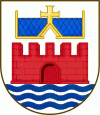Faaborg
 |
Faaborg is first mentioned as Foburgh in a document located in the French National Archives in Paris dated 25 June 1229. It is a deed of gift that gives Faaborg and the south of Funen as a morning present to Eleanor of Portugal, from Valdemar II to his daughter-in-law. It is mentioned as a castle (Foburgh meaning Fox Castle), so it must have existed before this date. However, this date has been used as the birth date of Faaborg and thus the town celebrated its 775th anniversary in 2004.
Although it is not known when the settlement was established, it appears Faaborg had already received privileges as a market town in the 13th century. Located on a promontory surrounded by water on three sides, the site was further protected by a moat and a town wall. Around 1477, a monastery was established which over the years acquired most of the property in the town and its surroundings. After the Reformation it was used for a time as a hospital until it was finally demolished. The monastery chapel became the parish church.
In the 16th and 17th centuries, Faaborg had to compete with a considerable amount of illegal trading from other settlements along the coast. In the mid-17th century, it suffered even more from the effects of the Swedish Wars but it began to prosper as an important port in the 18th century. Corn was exported to Norway and trade increased with the Grand Duchies of Schleswig and Holstein. By the 1890s, ships from Faaborg sailed as far as the Mediterranean. In the 19th century, the United Kingdom replaced Norway as the main trading partner and, in the second half of the century, trade extended to China and Australia. By the end of the century, there had been a huge increase in population (from 1,000 to 4,000) and a number of light industries had been established. Many of the new inhabitants came from Schleswig and Holstein after these had been lost to Germany. They included many Jews who made Faaborg Funen's most Jewish community with its own synagogue. With 50 employees, Dansk Vin- og Konservesfabrik (wine and canning) was the main business but traditional crafts and trading continued while the harbour was also enlarged. Steamship links with Copenhagen and Southern Jutland were established and in the 1880s railway connections were ensured with the other towns on the island.
Growth was more modest in the 20th century in the face of competition from Odense and Svendborg. A few new industries emerged in food processing and metal working but tourism and services became the leading areas of growth. By 2007, Faaborg had 7,318 inhabitants.
Map - Faaborg
Map
Country - Denmark
 |
 |
| Flag of Denmark | |
As of 2013, the Kingdom of Denmark, including the Faroe Islands and Greenland, has a total of 1,419 islands above 100 m2; 443 of which have been named and of which 78 are inhabited. Spanning a total area of 42943 km2, metropolitan Denmark consists of the northern part of the Jutland peninsula and an archipelago of 406 islands. Of these, the most populated island is Zealand, on which the capital Copenhagen is situated, followed by Funen, the North Jutlandic Island, and Amager. Denmark's geography is characterised by flat, arable land, sandy coasts, low elevation, and a temperate climate. As of 2022, it had a population of 5.928 million (1 October 2022), of which 800,000 live in the capital and largest city, Copenhagen. Denmark exercises hegemonic influence in the Danish Realm, devolving powers to handle internal affairs. Home rule was established in the Faroe Islands in 1948 and in Greenland in 1979; the latter obtained further autonomy in 2009.
Currency / Language
| ISO | Currency | Symbol | Significant figures |
|---|---|---|---|
| DKK | Danish krone | kr | 2 |
| ISO | Language |
|---|---|
| DA | Danish language |
| EN | English language |
| FO | Faroese language |
| DE | German language |















